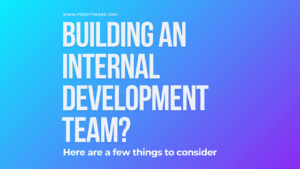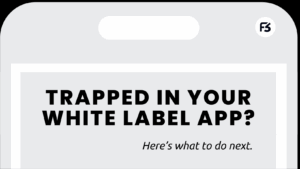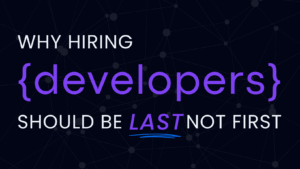Author: F3
Trapped In Your White Label App? Here’s What to Do Next
Still Asking For An Hourly Rate? You Should Really Consider This.
Outsourcing mobile app development often starts with a simple question: “What’s your hourly rate?” Many businesses fixate on this number, hoping a lower rate will save money. But this focus on hourly cost can be a trap. It overlooks the bigger picture—the time involved and the outcomes delivered. In reality, time is a far more critical asset in your project than a few dollars per hour. This blog post will explain why fixed pricing offers better value than hourly billing by highlighting the value of time, illustrating how hourly billing can backfire, and showing how fixed-price engagements drive superior results for your business.
Quick Links
- The Hourly Rate Trap: Saving Pennies, Losing Time
- A Thought Experiment: What Is More Valuable?
- The Hidden Costs of Hourly Billing
- Well-Defined Scope – Predictable Cost and Outcome
- Why Fixed Pricing Drives Better Results
- Focus on Results, Not Hours
- Hourly vs. Fixed Pricing for Mobile App Development
- Related Insights
The Hourly Rate Trap: Saving Pennies, Losing Time
It’s natural to want to minimize costs. However, companies often concentrate too much on saving money per hour without considering the time saved or lost in the process. An inexperienced team at $50/hour might sound like a bargain—until they take twice as long (or longer) to deliver your app. A more experienced developer at $100/hour could finish the same work in a fraction of the time. In the end, the “cheaper” $50/hour option could easily cost more overall and delay your launch. As one industry insight puts it, not all development teams deliver equal results in equal time; skill and experience dramatically impact how fast and well the work gets done. Hourly rates alone don’t reflect productivity or quality. Focusing solely on the sticker price per hour can lead you to false economies—situations where you save on rates but lose far more in extended timelines or subpar output.
Time: The One Asset You Can’t Get Back
In business, time is the most valuable asset. You can always generate more revenue or adjust budgets, but time once spent is gone forever. As entrepreneur Graham Duncan noted, time is our most important asset and the only thing we can’t get back once it’s spent. Every extra week or month your project drags on is lost opportunity: competitors move ahead, market needs evolve, and you miss out on potential sales or user growth. Speed to market matters. A lower hourly rate means nothing if a project that should take 3 months ends up taking 6. In contrast, investing in a skilled team that delivers faster can accelerate your return on investment. In short, time saved is money saved (and often money earned). Companies must remember that saving a few dollars per hour is pointless if it costs weeks of delayed revenue or progress. Time is free but priceless – once you lose it, you can’t recover it.
A Thought Experiment: What Is More Valuable?
Let’s put the time-vs-money question in perspective. Imagine two scenarios for a critical new feature in your mobile app:
Two Scenarios
Option A – Fixed Price
A developer quotes a fixed price of $20,000 and promises to deliver the feature in 1 month. This developer’s effective rate might be high, but they are confident in a swift turnaround.
Option B – Hourly Rate
Another developer offers to do the work at an hourly rate that comes out to half the cost per hour. However, based on their estimate, delivering the feature will take 3 months of work (resulting in, say, $15,000 total).
Comparing Both Options
At first glance, Option B has a lower sticker price ($15k vs $20k). But ask yourself: Would you pay $5,000 more to have the feature ready two months sooner? In many cases, the answer is yes. Those two saved months could allow you to launch earlier, start earning revenue, or seize a market opportunity before it’s gone. In fact, studies of consumer behavior show people are often willing to pay a premium to save time. The same principle applies to businesses: time saved in development can translate to significant value. If a feature delivered in 1 month instead of 3 could, for example, generate $50,000 in additional sales or strategic advantage, the extra $5k cost is a smart investment. The lesson: don’t evaluate cost in a vacuum. Consider the value of time and the outcomes gained by speeding up delivery. A higher upfront price for faster delivery can be far more cost-effective when you weigh the business benefits of that saved time.
The Hidden Costs of Hourly Billing
Hourly billing might seem straightforward—pay for the hours worked, no more, no less. But this model has hidden costs and pitfalls that can make it more expensive and less efficient in the long run:
Incentive To Drag On
Hourly contracts inherently create misaligned incentives. The more hours a project takes, the more the developer or agency earns, which is the opposite of what you as the client want. This can happen even with the best intentions: there’s simply no strong incentive to optimize for speed. As experts bluntly note, hourly billing punishes efficiency and rewards longer hours. If a developer finds a way to finish faster, they actually earn less—so hourly billing can unintentionally encourage dragging out the work. This doesn’t mean every hourly-paid developer works slowly on purpose; however, the structure penalizes those who are quick and efficient. In contrast, a fixed price model flips the incentive: the provider benefits by delivering efficiently, and you benefit from getting your result sooner.
Paying For Uncertainty
If you find yourself haggling over an hourly rate or the number of hours, it might be a red flag that you haven’t clearly defined what you’re building yet. Hourly (or “time & materials”) engagements are often used when the project scope is unclear or likely to change. In other words, you’re agreeing to start work without a firm definition of the finished product. This can lead to an open-ended timeline where delays and endless revisions drive up the cost. Every new idea or change request means more hours billed. Without a clear destination, the project can meander, and you are essentially funding that wandering process. It’s no surprise that hourly projects sometimes run over budget and over schedule – the lack of upfront definition is paid for in countless incremental hours.
Management Overhead & Delays
Hourly billing often means continuous tracking, monitoring, and even micromanaging hours. Both you and the vendor spend time auditing timesheets and negotiating extensions. This can create friction and slow down progress. Additionally, if a project hits a snag or a developer underestimates the effort, you face a choice: either cut features or pay for more hours. Such mid-project renegotiations can halt momentum and strain the relationship. In contrast, with a fixed price, both parties agree on deliverables and costs up front, drastically reducing billing disputes or mid-stream haggling over money. The team can get on with the work without constantly watching the clock or justifying every hour.
The Bottom Line – What Costs More?
The bottom line is that hourly billing can actually cost more – not just in dollars, but in lost time, delayed launches, and headaches. It often feels flexible at first, but that flexibility can become a liability if the project lacks focus. If you’re focused on hourly rates, it might be time to step back and ask whether the project itself has been fully thought through. As the saying goes, “If you fail to plan, you plan to fail.” In software terms, failing to define your app upfront means you’re almost choosing a longer, costlier journey via hourly work.
Well-Defined Scope – Predictable Cost and Outcome
How do you escape the hourly treadmill? The answer is simple: define what you need, and pursue a fixed-price engagement for it. A common reason companies default to hourly contracts is that the scope of work is fuzzy. But once you clearly define the product or feature you want, a fixed price becomes not only possible but advantageous. In fact, a precisely defined scope is a prerequisite for fixed pricing. When the development team and you as the client share a crystal-clear understanding of the requirements, deliverables, and acceptance criteria, you can lock in a price and timeline with confidence.
Investing time and effort up front to define your app or feature pays off massively. With a detailed specification or project brief in hand, you can approach a firm like F3Software for a fixed-price quote. This quote will encompass the entire feature or application: what it will do, how long it will take to build, and how much it will cost. Now, instead of an open meter running indefinitely, you have a concrete budget and schedule. Both parties can focus on the results to be achieved, not the hours ticking away.
Fixed pricing also forces important discussions early in the project. Ambiguities get resolved during the planning phase rather than turning into expensive misunderstandings later. When everything is well-defined, you greatly reduce the chance of “surprises” during development. The project is far less likely to veer off course or balloon in scope without anyone noticing. In a sense, fixed scope and pricing bring discipline to both client and developer: you agree on what “done” looks like from the start.
Does this mean changes can never happen? Not at all. It just means any change is a conscious decision with clear impact on cost and timeline. If new ideas emerge mid-project, they can be addressed separately (e.g. as a phase two or a contract addendum) rather than quietly absorbing extra hours in the background. This clarity helps you, as a business, make informed decisions about trade-offs: “Is this new feature worth delaying launch or increasing budget?” There’s no ambiguous middle ground where scope creep hides. You’re in control of if and when to adjust the plan, rather than discovering too late that the budget blew up.
Why Fixed Pricing Drives Better Results
When done right, fixed-price engagements create a win-win scenario built on accountability and aligned goals. Here’s why a fixed pricing model often delivers better outcomes for all parties:
Outcome-Oriented Collaboration
With a fixed price, both the client and the development team have a singular focus: the outcome. The conversation shifts from “How many hours will this take?” to “What will we achieve and by when?” This aligns everyone’s attention on delivering the feature or product as agreed. As one expert notes, clients truly “want to pay for the final outcome,” not for time spent. By agreeing on a value for that outcome, we can concentrate on results rather than tracking hours. There’s no need for you to worry about every little task that’s happening; you care about the end result, and so do we.
Eliminating Scope Creep and Surprises
Fixed pricing inherently discourages scope creep. Since the scope is agreed upfront and tied to a set fee, any additional requests or “wouldn’t it be nice if…” ideas are clearly outside the original agreement. This doesn’t mean you can’t adjust course, but it means adjustments are deliberate and come with their own cost/time implications. As a result, you’re far less likely to end up with a product bloated with extra features you didn’t originally plan (and which cost extra time). This keeps the project lean and focused on the features that matter most. It also virtually eliminates billing disputes—no more arguments about whether a task was included or not, because everything is documented in the fixed-price scope. If it’s not in the scope and you want to add it, the change is discussed and agreed to separately. This clarity keeps the relationship between you and the development team positive and productive, rather than adversarial.
Aligned Incentives – Faster, Quality Delivery
Perhaps the biggest advantage is how fixed pricing aligns incentives. The development team is motivated to deliver on time (or early) and with high quality, because that’s how they protect their profit and reputation. If we at F3Software quote a fixed price, it’s on us to make sure we execute efficiently. Any delays or mistakes on our part eat into our own time and margins, not your budget. This means you’re effectively rewarding us for efficiency and expertise. Experienced professionals love this model because it rewards their speed and skill, rather than punishing it. Remember how hourly billing penalizes a fast, capable developer? In a fixed-price scenario, a fast developer is an asset: they deliver great work quickly and can move on to the next project, all while you get the benefit of a quicker launch. Industry veterans have criticized hourly billing for penalizing experience and skill. Fixed pricing, on the other hand, lets experts leverage their years of know-how to deliver value faster – and get rewarded for it. For the client (you), this means you’re paying for the accumulated expertise and the outcome, not for how long someone sits at a keyboard. You get seasoned developers who take pride in meeting the agreed goals, not junior people racking up hours.
Quality and Accountability
With a fixed price tied to defined deliverables, the development team is fully accountable for meeting the agreed-upon acceptance criteria. There is no incentive to cut corners or say “out of scope” for basic quality issues – the deliverable has to meet the standards set in the contract. At the same time, because we want to avoid costly rework, we have an incentive to “do it right the first time.” Thorough testing, good architecture, and proactive problem solving are in everyone’s interest. In an hourly model, a cynical view is that rework or issues mean more billable hours. But in a fixed model, preventing issues saves everyone time and money. The result is often higher quality output. As one article on software cost notes, investing in experienced talent and good planning upfront leads to fewer revisions later– exactly what a fixed-fee project encourages. In the end, you receive a polished product on the timeline promised, for the price you expected.
Focus on Results, Not Hours
It’s time to change the way we talk about outsourced development. Stop asking about hourly rates, and start asking about outcomes and value. Your project’s success will not be determined by the cheapest developer you can hire by the hour – it will be determined by the expertise, efficiency, and clarity that an experienced team brings to the table. Remember, time is money, but more importantly, time is opportunity. Every hour saved in development is an hour gained for your business to prosper. Don’t fall into the trap of penny-pinching on hourly rates only to spend dollars on delays.
At F3Software, we believe in delivering high-value outcomes, not just billable hours. Our fixed-price approach to mobile app development ensures you know exactly what you’re getting, when you’ll get it, and what it will cost. No surprises – just a laser focus on building the product you need to move your business forward. If you have a project in mind, let’s define it together and get it done the right way, fast.
Ready to turn your app idea into a reality without the hourly headaches? Contact F3 today to discuss your project. Let’s focus on results, not hours, and make the most of your most precious asset: your time. Your success is our finish line, and we’re excited to help you cross it with confidence.
Hourly vs. Fixed Pricing for Mobile App Development
Hourly billing can lead to rushed work or corner-cutting to maximize hours, compromising quality. Fixed pricing ties payment to deliverables, ensuring thorough testing and robust architecture. This focus on quality, driven by clear acceptance criteria, delivers a polished app, unlike hourly models where rework may increase costs.
Unclear scopes in hourly contracts invite scope creep, revisions, and budget overruns, as new features add hours. Studies show 50% of projects exceed budgets due to poor planning. Fixed pricing requires a defined scope upfront, minimizing surprises and ensuring predictable costs.
Fixed pricing shifts focus to shared goals, fostering collaboration on outcomes rather than hours. Both client and developers align on deliverables, reducing disputes and enhancing teamwork. This outcome-driven approach, unlike hourly billing’s focus on timesheets, ensures a productive partnership.
Yes, fixed pricing suits complex projects with a well-defined scope. Breaking the project into phases with clear milestones ensures manageability and cost control. Unlike hourly billing, which risks open-ended costs, fixed pricing provides clarity, even for intricate apps.
Fixed pricing incentivizes developers to deliver efficiently, speeding up timelines. A 2024 study found faster delivery boosts ROI by 20% ([Forrester]([invalid url, do not cite])). Unlike hourly billing, which may delay launches, fixed pricing ensures your app reaches the market sooner, capturing opportunities.
Ask about deliverables, timelines, and acceptance criteria to focus on outcomes. Inquire how they ensure quality and handle scope changes. This shifts the conversation to value, aligning with fixed pricing’s emphasis on results over hours, ensuring a successful project.
Define a clear scope and choose fixed pricing to lock in costs. Hourly billing risks overruns, with 50% of projects exceeding budgets. A detailed project brief and fixed-price agreement minimize surprises, keeping your budget on track.
Define a clear scope and choose fixed pricing to lock in costs. Hourly billing risks overruns, with 50% of projects exceeding budgets. A detailed project brief and fixed-price agreement minimize surprises, keeping your budget on track.
Fixed pricing lets experienced developers leverage their efficiency, delivering faster without losing income, unlike hourly billing, which penalizes speed. Their expertise ensures quality and timely delivery, benefiting clients with quicker launches and reliable apps.
Fixed pricing eliminates timesheet tracking and billing disputes, reducing oversight needs. With agreed deliverables and costs, you focus on outcomes, not hours. Hourly billing’s constant monitoring adds stress, while fixed pricing streamlines management for a smoother process.
Start with a detailed scope, collaborate on requirements, and set clear milestones. Regular check-ins ensure alignment. Fixed pricing thrives on clarity, unlike hourly billing’s ambiguity. This structured approach, supported by agencies like F3 Software, delivers predictable, high-quality results.
Related Insights
- The Model Context Protocol: Unifying AI Integrations for Better Software Development

- MCP Servers Every Developer Should Know

- Leveraging Autonomous AI Coding Agents for Smarter Software Development

- Windsurf: Supercharging Our AI-Driven Development

- Cursor IDE : Leveraging AI-First and Agentic AI

- Why Context-Aware AI Matters for Enterprise Success

- Want to Replace your dev team with AI Tools? Let’s Talk Through That First.

- The Hidden Cost of Outsourcing

- Building An In-House Development Team? Here Are A Few Things To Know

- Why You Should Break Up With Your Next Big App Idea

- React Native VS Flutter? The 5 Questions You Should Really Answer First

- Trapped In Your White Label App? Here’s What to Do Next

- Still Asking For An Hourly Rate? You Should Really Consider This.

- Top 10 App Launch Checklist: Your Step-by-Step Guide to a Successful Mobile App Launch

- 5 Reasons to Hire a Mobile App Agency Instead of Building In-House

- Why Hiring Developers Should Come Last, Not First

Top 10 App Launch Checklist: Your Step-by-Step Guide to a Successful Mobile App Launch
In today’s digital age, mobile apps are essential for businesses and entrepreneurs looking to connect with users. However, the app market is fiercely competitive, with over 5.5 million apps available across the Google Play Store and Apple App Store. Alarmingly, research indicates that 99.5% of consumer apps fail to achieve significant traction, often due to inadequate market validation, poor user experience, or lack of a robust launch strategy. To help you beat the odds, we’ve crafted a Top 10 App Launch Checklist—a comprehensive, step-by-step guide to navigate each phase of your app’s journey, from ideation to post-launch success.
This checklist is designed for both novice and experienced developers, offering actionable insights to ensure your app not only launches smoothly but also thrives in a crowded market. By following these steps, you can address common pitfalls and position your app for long-term engagement and growth.
Top 10 Launch Checklist
- 1. Validate Your App Idea with Real Users
- 2. Define Your Target Audience Clearly
- 3. Start Simple and Focus on Core Features
- 4. Invest in Good User Experience and Design
- 5. Choose the Right Tech Stack for Your Goals
- 6. Build a Minimum Viable Product (MVP)
- 7. Develop Your Marketing Strategy Early
- 8. Do Extensive Testing Across Many Devices
- 9. Prepare Early for App Store Submission
- 10. Plan for Continuous Updates and User Support
- Additional Considerations
- Why This Checklist Works
- Launching a Mobile App Common Questions
- Related Insights
1. Validate Your App Idea with Real Users
Before investing time and resources, confirm that your app idea has a real market demand. Conduct surveys, interviews, or small focus groups to gather feedback from potential users. This early validation helps refine your concept and ensures it addresses a genuine need.
Why It Matters: Many apps fail because they don’t solve a specific problem. For example, Fyresite notes that a lack of product-market fit is a primary reason for the 99.5% failure rate of consumer apps (Fyresite).
How to Do It:
- Use tools like SurveyMonkey or Typeform to create user surveys.
- Host focus groups via platforms like UserTesting to observe real-time reactions.
- Ask open-ended questions to uncover user pain points and preferences.
Example: If you’re developing a budgeting app, ask potential users about their current financial management challenges to ensure your app addresses their needs.
2. Define Your Target Audience Clearly
Understanding who your app is for is crucial. Define your target users’ demographics (age, gender, location), behaviors (hobbies, tech usage), and needs (specific problems they face). This clarity will shape your app’s design, features, and marketing strategy.
Why It Matters: A well-defined audience ensures your app resonates with its intended users, increasing engagement and retention.
How to Do It:
- Create user personas to represent your ideal users. For instance, a fitness app might target “Sarah, a 30-year-old working professional who wants quick home workouts.”
- Use Google Analytics or social media insights to analyze demographic data.
- Study competitors to identify gaps in their audience targeting.
Tip: Tailor your app’s tone and features to your audience. A younger demographic might prefer vibrant visuals, while professionals may value efficiency.
3. Start Simple and Focus on Core Features
Resist the temptation to pack your app with every possible feature. Identify the essential features that directly solve your users’ primary problem. A simple, focused app is easier to develop, test, and use, increasing its chances of success.
Why It Matters: Overloading an app with features can confuse users and delay your launch. A streamlined approach ensures a polished user experience.
How to Do It:
- List all potential features, then prioritize those that align with your app’s core purpose.
- Use the MoSCoW method (Must-have, Should-have, Could-have, Won’t-have) to categorize features.
- Focus on delivering a single, high-quality solution before expanding.
Example: For a note-taking app, prioritize text input and organization features over advanced options like voice notes or cloud syncing.
4. Invest in Good User Experience and Design
A seamless user experience (UX) and visually appealing user interface (UI) are critical for retaining users. Prioritize an intuitive, easy-to-navigate design that keeps users engaged. If design isn’t your strength, hire a professional UI/UX designer.
Why It Matters: Forrester reports that 88% of consumers value a company’s experience as much as its products (Forrester). A poor UX can lead to high uninstall rates.
How to Do It:
- Use prototyping tools like Figma or Adobe XD to test designs.
- Follow design best practices, such as consistent color schemes and clear call-to-action buttons.
- Conduct usability testing to ensure your app is intuitive.
Tip: Keep accessibility in mind—use high-contrast colors and readable fonts to accommodate all users.
5. Choose the Right Tech Stack for Your Goals
Your choice of technology impacts your app’s performance, cost, and development speed. Decide whether native development (iOS/Android), React Native, or Flutter best suits your needs. Each option has trade-offs, so align your choice with your app’s goals.
Why It Matters: The wrong tech stack can lead to performance issues or higher costs, affecting your app’s success.
How to Do It:
- Native Development: Ideal for high-performance apps (e.g., gaming) but more expensive.
- React Native/Flutter: Cross-platform frameworks that reduce development time and cost, suitable for most apps.
- Consult with developers to assess your app’s technical requirements.
Example: A social media app with basic features might use React Native for faster development, while a graphics-heavy game might require native development.
6. Build a Minimum Viable Product (MVP)
Launch with a basic version of your app that includes only core features. An MVP allows you to test the market, gather user feedback, and iterate before committing to full-scale development.
Why It Matters: MVPs minimize risk by validating your app’s value with real users, saving time and resources.
How to Do It:
- Develop only the must-have features identified in step 3.
- Launch to a small group of users to collect feedback.
- Use feedback to prioritize future updates.
Example: For a delivery app, an MVP might include order placement and tracking, with advanced features like real-time driver chat added later.
7. Develop Your Marketing Strategy Early
Don’t wait until launch day to start marketing. Begin building excitement early by creating a website, collecting email sign-ups, and engaging on social media. A strong pre-launch strategy can drive initial downloads and user interest.
Why It Matters: Marketing is often the biggest challenge for app developers, according to an InMobi survey (Alchemer). Early efforts increase visibility.
How to Do It:
- Create a landing page with tools like Wix or Squarespace.
- Share teasers on platforms like X or Instagram to build anticipation.
- Offer incentives, such as early access or discounts, for pre-launch sign-ups.
Tip: Use Mailchimp to manage email campaigns and keep your audience informed.
8. Do Extensive Testing Across Many Devices
Ensure your app works seamlessly across various devices, operating systems, and screen sizes. Thorough testing identifies and fixes bugs, while beta testing with real users provides valuable feedback before launch.
Why It Matters: Technical issues, such as crashes, are a leading cause of app uninstalls, with Forbes noting that 71% of uninstalls are due to software crashes (Clarion Tech).
How to Do It:
- Test on popular devices using emulators or services like BrowserStack.
- Conduct unit, integration, and system testing to cover all functionalities.
- Use beta testing platforms like TestFlight (iOS) or Google Play Console (Android).
Tip: Encourage beta testers to provide detailed feedback on usability and performance.
9. Prepare Early for App Store Submission
App stores have strict guidelines, so prepare your listing assets well in advance: clear descriptions, high-quality screenshots, an engaging icon, and optimized keywords for discoverability. Submit early versions for review to address any issues with time to spare.
Why It Matters: App Store Optimization (ASO) improves your app’s visibility, helping it stand out among millions of competitors.
How to Do It:
- Research keywords using tools like Sensor Tower or App Annie.
- Create compelling visuals that showcase your app’s key features.
- Follow Apple and Google’s submission guidelines to avoid rejections.
Tip: Submit your app at least a week before your planned launch to account for review times.
10. Plan for Continuous Updates and User Support
Launch day is just the beginning. Be prepared to address user feedback, release regular updates, fix bugs, and introduce new features to keep your app relevant and engaging.
Why It Matters: Regular updates demonstrate commitment to user satisfaction, boosting retention and encouraging positive reviews.
How to Do It:
- Set up in-app feedback tools or a support email using platforms like Intercom or Zendesk.
- Monitor user reviews on app stores and respond promptly to concerns.
- Plan a roadmap for updates based on user feedback and market trends.
Example: If users request a dark mode for your app, prioritize it in your next update to enhance user satisfaction.
Additional Considerations
Beyond these 10 steps, consider the following to enhance your app’s success:
- Security Measures: Implement advanced encryption to protect user data, as security breaches can erode trust (Smarther).
- Competitor Analysis: Study competitors to identify opportunities for innovation and differentiation.
- Post-Launch Metrics: Track key performance indicators (KPIs) like downloads, retention rates, and user ratings to measure success.
Why This Checklist Works
This checklist addresses the most common reasons for app failure, such as lack of market fit, poor UX, and inadequate marketing. By following these steps, you can create an app that not only launches successfully but also builds a loyal user base. The structured approach ensures you stay organized and focused, even in the fast-paced world of app development.
Conclusion
Launching a mobile app is a challenging but rewarding endeavor. With the right strategy, you can navigate the complexities of the app market and create a product that resonates with users. This Top 10 App Launch Checklist provides a clear, actionable roadmap to guide you through each phase, from validating your idea to maintaining user engagement post-launch. By investing in market research, user-centric design, and ongoing support, you can significantly increase your app’s chances of success.
Start implementing this checklist today, and take the first step toward launching an app that stands out in a crowded market. Your users are waiting—make their first experience with your app unforgettable.
Launching a Mobile App Common Questions
Many mobile apps fail due to lack of product-market fit, poor user experience, or inadequate marketing. To avoid these pitfalls, validate your app idea with real users, prioritize intuitive design, and develop a robust marketing strategy early, as outlined in the blog post.
Validate your app idea by conducting surveys, interviews, or focus groups with potential users. Tools like SurveyMonkey or Typeform can help gather feedback to confirm your app addresses a genuine need.
Key steps include validating your idea, defining your target audience, focusing on core features, investing in UX/UI design, choosing the right tech stack, building an MVP, marketing early, testing thoroughly, optimizing for app stores, and planning for updates.
Defining your target audience ensures your app’s features, design, and marketing resonate with users, boosting engagement and retention. Creating user personas, as suggested in the blog post, helps tailor your app to specific demographics and needs.
Prioritize features by identifying those that directly solve your users’ primary problem, using methods like MoSCoW to categorize must-have versus nice-to-have features. This keeps your app focused and user-friendly.
A seamless user experience (UX) and appealing user interface (UI) are critical for retention. Research from Forrester shows 88% of consumers value experience as much as the product, making professional design essential, as noted here.
Choose a tech stack based on your app’s goals, considering factors like performance, cost, and development speed. Options like native development or cross-platform frameworks like React Native or Flutter should align with your needs, as discussed.
An MVP is a basic version of your app with core features, allowing you to test the market and gather feedback before full development. This minimizes risk and saves resources, a key strategy highlighted above.
A successful app marketing strategy involves early promotion through a landing page, social media engagement on platforms like X, and email campaigns using tools like Mailchimp. Building excitement pre-launch drives downloads, as advised in the blog post.
Improve visibility through app store optimization (ASO) by researching keywords with tools like Sensor Tower or App Annie, creating compelling visuals, and following store guidelines.
Related Insights
- The Model Context Protocol: Unifying AI Integrations for Better Software Development

- MCP Servers Every Developer Should Know

- Leveraging Autonomous AI Coding Agents for Smarter Software Development

- Windsurf: Supercharging Our AI-Driven Development

- Cursor IDE : Leveraging AI-First and Agentic AI

- Why Context-Aware AI Matters for Enterprise Success

- Want to Replace your dev team with AI Tools? Let’s Talk Through That First.

- The Hidden Cost of Outsourcing

- Building An In-House Development Team? Here Are A Few Things To Know

- Why You Should Break Up With Your Next Big App Idea

- React Native VS Flutter? The 5 Questions You Should Really Answer First

- Trapped In Your White Label App? Here’s What to Do Next

- Still Asking For An Hourly Rate? You Should Really Consider This.

- Top 10 App Launch Checklist: Your Step-by-Step Guide to a Successful Mobile App Launch

- 5 Reasons to Hire a Mobile App Agency Instead of Building In-House

- Why Hiring Developers Should Come Last, Not First

5 Reasons to Hire a Mobile App Agency Instead of Building In-House
Why Hiring Developers Should Come Last, Not First
So, you have a brilliant idea for a mobile app and you’re eager to start building. It’s tempting to hire developers right away and get coding. But bringing developers in too early – before you’ve nailed down your product vision and requirements – is a common pitfall. It’s a bit like trying to build a house without a blueprint – a recipe for confusion, rework, and runaway costs. In this post, we’ll chat about why you should focus first on your app’s vision, market fit, and clear requirements before writing a single line of code. Doing so will save you time, money, and headaches, and ultimately set your development team up for success.
Quick Links
Clear Requirements Are Key to Developer Productivity and Project Success
Why Unclear Requirements Frustrate Developers and Stall Progress
Developers are natural problem solvers who thrive when given clear, well-defined challenges to tackle. When you hand a developer vague or frequently changing requirements, their productivity takes a significant hit. They end up second-guessing decisions, waiting for clarifications, or repeatedly rewriting code to adapt to shifting expectations. Few scenarios frustrate developers more than putting days or even weeks of effort into a feature, only to discover later that it’s not what stakeholders wanted. Such ambiguity not only dampens team morale but also slows momentum, introduces confusion, and makes it difficult to measure real progress on your project.
The Costly Impact of Poorly Defined Requirements—and How to Fix It
The financial and timeline implications of unclear requirements are substantial. Industry studies consistently show that around half of all software development efforts are wasted due to missing, vague, or changing requirements. Imagine the impact of losing 50% of your budget or schedule simply because your team didn’t have precise guidelines at the outset. By contrast, well-defined requirements empower developers to write efficient, focused code from the very start. Clear and stable specifications reduce costly rework, help maintain high-quality standards, and allow your team to consistently meet deadlines. Investing time upfront to clarify exactly what needs to be built, why it’s needed, and how it aligns with user goals significantly increases your likelihood of success—both technically and financially.
A Clear Vision Upfront Prevents Costly Rewrites
How Vision Clarity Protects Your Project Budget and Timeline
A solid, clearly defined product vision isn’t merely a helpful starting point—it’s a critical foundation that keeps your project focused and your budget intact. Without clarity upfront, it’s easy for your team to pivot frequently, introducing new ideas or redefining goals as the project evolves. Each of these shifts might require significant rework, forcing developers to rewrite, discard, or restructure existing code. Over time, this leads to wasted resources, ballooning costs, and delayed timelines. Worse yet, constant changes and discarded effort can demoralize your development team, making progress slower and more difficult with each iteration.
Using a Product Roadmap to Prevent Scope Creep and Rework
Think of your product roadmap as a protective barrier against “scope creep”—the tendency for projects to grow out of control as new, unplanned ideas continuously enter the picture. Without a roadmap, there’s nothing to prevent these frequent detours, resulting in unexpected costs, longer timelines, and compromised quality. A clearly articulated roadmap defines exactly which features will (and won’t) be built at each stage, helping your team stay aligned and preventing costly backtracking or redundant effort. Investing time early to refine your roadmap means developers can confidently build the product right the first time, delivering precisely what users need without unnecessary rewrites and delays.
Know Your Users and Their Needs Before You Code
Clearly Define Your Target Users to Solve Real Problems
An app without clearly defined target users is essentially a solution in search of a problem. Before your developers write a single line of code, you need to pinpoint exactly who your app is intended for and understand their genuine needs. Clarifying the target audience and their core challenges gives your entire team critical context, ensuring everyone is aligned from the outset. Developers aren’t just coding to vague specifications; they’re building features that directly address meaningful, user-validated problems. This approach streamlines both design and development, resulting in a more focused, efficient, and purposeful workflow.
Why Market Fit Matters: Avoiding Costly Mistakes
A user-centered approach significantly increases your app’s likelihood of success. Skip this step, and you risk developing something that completely misses the mark. Industry research underscores this risk clearly—approximately one-third of startups fail because they built products nobody truly wanted or needed. Avoid becoming part of this statistic by doing thorough market-fit research upfront. Talk directly with potential users, validate that your app idea resonates with them, and clearly identify the most impactful features. This proactive validation ensures your developers are always focused on creating real value, rather than simply fulfilling arbitrary requirements.
How User Personas Keep Your Team Aligned
Defining and utilizing user personas throughout your app’s development lifecycle is central to effective product planning. Personas don’t just inform initial design decisions—they continue guiding the team during analysis, testing, and refinement phases. By consistently referring back to clearly documented personas, your developers remain aligned on exactly whose problem they’re solving. Maintaining this clarity helps prevent misunderstandings, reduces unnecessary work, and ensures that every team member stays focused on delivering an app that meets real-world needs.
Validate Your Idea Before Hiring Developers to Avoid Costly Mistakes
Launching a startup is exhilarating, but diving headfirst into development without validating your idea can lead to costly missteps. By prioritizing idea validation, you ensure your resources are invested wisely, building a product that resonates with your target audience. Below, we explore three critical reasons why validating your idea before hiring developers is essential for startup success, optimized for search engines with actionable insights for early-stage founders.
Why Rushing into Development Without Validation Drains Your Budget
Enthusiasm for a new app or tech product often pushes founders to hire developers prematurely, but this can lead to financial pitfalls. Without validating your idea, you risk investing in code that may need extensive revisions or become obsolete if your concept doesn’t align with market needs. For example, startups frequently spend tens of thousands of dollars on development only to discover their product lacks product-market fit. This misstep stems from the pressure to demonstrate progress by building quickly, bypassing the crucial step of confirming user demand. By conducting market research, such as user interviews or surveys, you can gauge interest and refine your concept before committing to costly development. Validation minimizes the risk of building the wrong product, saving your startup from budget overruns and ensuring resources are allocated to a viable idea.
How Discovery and Validation Set the Stage for Successful Development
A strategic approach to product development begins with discovery and validation, not coding. Start by engaging your target audience through interviews, focus groups, or online surveys to understand their pain points and preferences. Next, create a low-fidelity prototype or minimum viable product (MVP)—such as a clickable wireframe or a basic landing page—to test your concept in real-world scenarios. Collect feedback to confirm whether your solution addresses a genuine need and if users are willing to adopt or pay for it. This iterative process helps refine your idea, ensuring it aligns with market demand before developers write a single line of code. By validating first, you provide developers with a clear, evidence-based roadmap, reducing the likelihood of costly pivots and ensuring efficient use of your development budget.
The Proven Roadmap Tech Leaders Use to Minimize Development Risks
Industry experts and tech leaders advocate a structured process to de-risk product development: discovery, validation, MVP definition, and then development. Begin with a discovery phase to define user needs, business objectives, and market opportunities. Next, validate your idea using prototypes or beta tests to gather real user feedback. For instance, tools like Figma or InVision can help create interactive prototypes, while platforms like Product Hunt can gauge early interest. Once validated, outline your MVP’s core features to address user needs without overbuilding. Only then should you hire developers to execute a well-defined plan. This approach, endorsed by leading tech agencies, ensures your development team focuses on building a product with proven demand, minimizing surprises and maximizing your startup’s chances of success.
A Clear Plan Lets Developers Write Better Code
Here’s the payoff: when you’ve done all the above – clarified your vision, confirmed the market fit, and nailed down detailed requirements – your developers can truly shine. With a clear plan in hand, the dev team isn’t wasting cycles on “what should we build” or coping with constant change; instead, they can focus on how to build it best. This means more time spent on writing clean, optimized, and scalable code. In a clear and steady environment, developers can choose the right architecture and technologies from the start (no need for band-aid solutions) and even innovate with confidence. As one expert noted, the very goal of good up-front software architecture is to ensure the highest possible quality, performance, and sustainability of the system. In other words, thoughtful planning paves the way for a robust, future-proof app.
Clarity also boosts morale and efficiency. When your team knows the exact game plan, they can get “in the zone” and code with focus and efficiency. They’ll build features with an eye on long-term maintainability and scalability, rather than just rushing to patch up a moving target. The end result for you? A better product built faster. Your app will be more stable and optimized from day one, because it was built on a solid foundation. By giving developers a clear blueprint, you empower them to do their best work – crafting an app that not only meets the requirements but does so with clean, high-quality code under the hood.
Conclusion: Build Smarter, Not Harder
At the end of the day, developers are essential to bringing your mobile app vision to life – but their talents are best used when you’ve done your homework first. Taking the time to solidify your product vision, validate it with real users, and define clear requirements isn’t a delay; it’s an investment in building the right thing, the right way. It spares you from costly missteps and sets your developers up to deliver a truly great app.
Ready to turn your well-defined app idea into reality? Let’s talk. Our agency specializes in guiding businesses through the planning stages and executing top-notch development. Whether you need help sharpening your product strategy or you’re prepared to build, we’re here to help. Reach out to us to plan or develop your mobile app – and let’s create something amazing, with clarity and confidence leading the way.
Frequently Asked Questions
Frequently Asked Questions
To make your requirements clear, write user stories (e.g., “As a user, I want to [action] so that [benefit]”) to define features from the user’s perspective. Add acceptance criteria to specify when a feature is complete. Use wireframes or mockups to show the app’s design and flow. Finally, prioritize features with a method like MoSCoW (Must, Should, Could, Won’t) to focus on what matters most. This clarity helps developers build exactly what you need without guesswork.
Without a solid vision, you risk scope creep, where new features pile up, delaying the project and increasing costs. You might also face costly rewrites if developers build features that don’t fit the final goal, forcing them to scrap or redo work. This wastes time, money, and morale. A clear vision keeps the project focused, reducing these risks and ensuring resources are used efficiently.
Research your audience with surveys, interviews, or market analysis to learn their demographics, habits, and challenges. Build a user persona—a detailed profile with their age, goals, and pain points—to represent your ideal user. Focus on the problems they need solved. This keeps your app aligned with real user needs from the start.
Validate your idea by running surveys to test user interest in the problem your app solves. Create a landing page to pitch the app and track sign-ups. Build a prototype with tools like Figma and get feedback from potential users. These steps confirm demand and refine your concept before you invest in coding.
A clear plan lets developers focus on writing clean, scalable code instead of reacting to vague or changing goals. They can pick the best architecture and tools upfront, avoiding messy fixes later. With a roadmap, they build with future growth in mind, creating a stable, high-quality app that’s easier to maintain.
A product roadmap is a plan that outlines your app’s key features, milestones, and timeline. It’s critical because it keeps the team aligned on priorities and deadlines, acting as a guard against scope creep. By defining what’s included, it prevents detours, saving time and money while ensuring the project stays on course.
Set a clear scope early and stick to it, using a roadmap to lock in priorities. Involve stakeholders upfront to agree on goals. Use a change control process to review new ideas for their impact on time and cost before adding them. Regular check-ins with the roadmap keep the project focused.
Collect feedback with surveys for broad input, interviews for deeper insights, and usability tests with prototypes to see how users interact with your app. Post-launch, use analytics to track behavior. These methods help you refine your app to meet real user needs.
Product discovery is the process of defining your app’s vision, researching user needs, and validating the idea with prototypes or feedback. Development is the coding phase that builds the app based on discovery findings. Discovery ensures you’re solving the right problem; development executes the solution.
Reach out to an agency after discovery and validation, when you have a clear vision, confirmed user demand, and detailed requirements. This ensures developers can jump in and build efficiently. If you need help with planning, some agencies offer discovery services to get you ready for development.
Trying to build an app without a clear plan is like building a house without a blueprint – it only leads to confusion, rework, and wasted effort. Developers do their best work when they know exactly what problem to solve, so defining your vision and requirements first means your team will build the right features from the start. In fact, studies show that around half of development effort can be lost to unclear or missing requirements. By investing time in planning and validation up front, you make sure your team spends time coding the right things – saving you money, time, and headaches in the long run
It might feel like planning slows you down, but doing the homework first actually speeds development overall. A clear plan prevents costly rewrites later: without it, adding or changing features mid-project can force developers to redo work One analysis found that unclear requirements can consume up to 40–50% of development time in rework. By nailing down the roadmap and core features ahead of time, your team avoids the endless cycle of coding and recoding. In the end, this approach lets you reach the market faster with a polished product, rather than rushing out something half-baked.
It’s still wise to pause and make sure everyone agrees on the vision, user needs, and feature list. Refining the plan now aligns the team on the right goals and actually saves time in the long run. As one expert notes, taking time to solidify your product vision isn’t a delay; it’s an investment in building the right thing. In other words, clarifying the direction before pressing ahead means your developers can be far more effective once coding resumes.
The best way is to validate your idea with real people. Talk to potential users and test your concept with prototypes, landing pages or simple demos. Gathering feedback early shows whether the app solves a genuine pain point before you invest heavily in development. This step is critical because many new products fail by building something nobody really wanted. By doing your homework on market fit up front, you make sure you’re investing in an opportunity people care about.
An MVP is a lean version of your app that includes only the essential features needed to test the idea. It’s a fast, low-cost way to let real users try your concept and give feedback. By building an MVP, you learn what works and what doesn’t before full-scale development. In fact, experts recommend defining your MVP’s must-have features early on as part of planning. This approach saves time and money by focusing only on the core value of your app at first.
Because an app without a defined user is like a solution looking for a problem. By identifying who will use your app and what they truly need, you ensure every feature addresses a real user pain point. This focus guides design and development so your team builds something people will actually want. When everyone understands the user’s goals from the start, developers spend time on the right solutions instead of guessing what might work. In short, building with the user in mind means your app is far more likely to succeed and avoids wasted effort.
Your requirements should clearly spell out what the app must do (and not do) – essentially a blueprint for the team. Developers excel when they know exactly which problem to solve. Vague or shifting requirements lead to confusion, wasted work and frustration. For example, saying “improve sales” without details will force developers to guess what you mean. Instead, write down the specific features and user actions you want. Well-defined requirements give developers a clear target, so they can code efficiently from day one.
A roadmap or product plan serves as a guide that keeps everyone on the same page. It defines which features and goals are in scope, so the team isn’t building extra or irrelevant functionality. Without a clear plan, it’s easy to start adding “just one more feature” and waste time on work that may get thrown out later In fact, studies show that unclear requirements can consume a huge chunk of development time in rework. By planning ahead, you focus your budget on the highest-value features and cut out wasted effort from the start.
During the planning phase, you set priorities and lock in what will be built first. Think of your roadmap as a shield against scope creep – if an idea doesn’t fit the original plan, it gets re-evaluated later instead of immediately added This keeps the development process steady and focused. By clearly defining what’s in or out of scope up front, your team can say “no” or “later” to non-essential ideas and avoid blowing up the schedule or costs. The result is a smoother project that stays on track and on budget.
You can create tangible outputs that demonstrate learning and momentum without writing full code. For example, build simple wireframes, mock-ups or a clickable prototype of key features. You could also test demand with a landing page or marketing survey. These activities let stakeholders see concrete results (like user feedback or validated features) before development begins. In short, this “discovery and validation” work not only earns trust but also ensures that when you do hire developers, you’ll have a clear, user-verified plan to build on.
Related Insights
- The Model Context Protocol: Unifying AI Integrations for Better Software Development

- MCP Servers Every Developer Should Know

- Leveraging Autonomous AI Coding Agents for Smarter Software Development

- Windsurf: Supercharging Our AI-Driven Development

- Cursor IDE : Leveraging AI-First and Agentic AI

- Why Context-Aware AI Matters for Enterprise Success

- Want to Replace your dev team with AI Tools? Let’s Talk Through That First.

- The Hidden Cost of Outsourcing

- Building An In-House Development Team? Here Are A Few Things To Know

- Why You Should Break Up With Your Next Big App Idea

- React Native VS Flutter? The 5 Questions You Should Really Answer First

- Trapped In Your White Label App? Here’s What to Do Next

- Still Asking For An Hourly Rate? You Should Really Consider This.

- Top 10 App Launch Checklist: Your Step-by-Step Guide to a Successful Mobile App Launch

- 5 Reasons to Hire a Mobile App Agency Instead of Building In-House

- Why Hiring Developers Should Come Last, Not First






